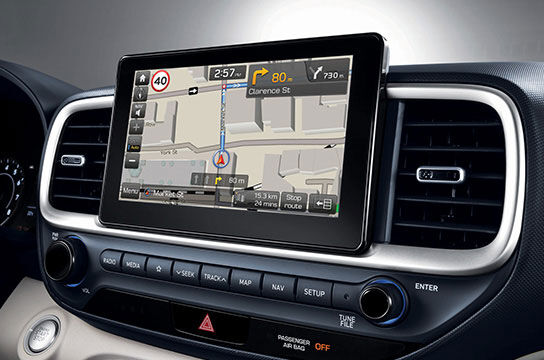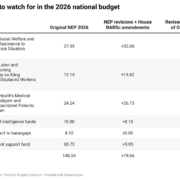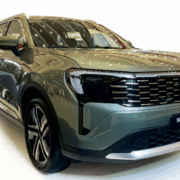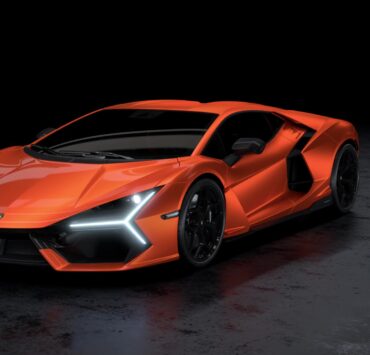Touchscreens: A distraction of growing proportions?

Picture this – you’re out on the road in your brand-new car.
It’s the end of the day and you’re looking forward to a sumptuous dinner with your loved ones. And because it’s sundown, the aircon settings you made earlier are now giving you hypothermia.
No worries – just twist a few knobs and all will be less frosty. But alas, your brand-new car doesn’t have a knob in sight.
And then you remember what the dealer told you about finding the climate-control functions with the touchscreen. You look ahead – traffic isn’t so bad – so you start digging through the various menus and submenus.
Nope, not that one. Not that one, either. What about this icon? Wait, where did that pedestrian come from? Bam!
Dinner with loved ones is no longer a priority – especially for the person bleeding out on the asphalt after being hit by a two-ton battering ram operated by someone who was just about to push the tiny red arrow to warm up a chilly cabin.
Deadly distractions
Touchscreens are undoubtedly one of the biggest trends in current automotive interior design.
These allow manufacturers to corral a car’s growing list of functions into one place, instead of creating an array of panels, switches and buttons. In other words, it’s a means to save money on manufacturing costs and upgrades, especially with the advent of over-the-air updates.
And aesthetically, getting rid of all those panels, switches and buttons makes for a neater cabin. But at what cost?
A March 2016 article in the peer-reviewed Proceedings of the National Academy of Sciences (PNAS), cited by NBC News earlier this month, said nearly nine in 10 road crashes in the United States were caused by driver-related factors.
The study also found that over half of observed crashes were because of distractions, including manipulating in-car devices like touchscreens. In fact, operating a touchscreen while driving (which naturally averts your eyes from the road) makes you 4.6 times more likely to get into a crash.
“Activities that require a driver to take his or her eyes off of the forward roadway result in the greatest risks,” the PNAS article said.
Top killer of 5-29 year-olds
But the dangers of being distracted by touchscreens isn’t just about the Americans or the odd fender-bender.
Road-safety advocates worldwide have criticized how legislation has significantly reduced smartphone use on the road, only for drivers to be distracted by touchscreens that are growing larger and larger.
Indeed, the PNAS findings are similar to those in the 2018 World Health Organization (WHO) Global Status Report on Road Safety, which noted the dangers of being distracted by smartphones and in-car devices.
The WHO said using handheld or hands-free telephone devices makes you four times more likely to get involved in a road crash, while texting (or typing into a screen) increases the risk by a staggering 23 times. And even in-car phone conversations have been found to be more distracting than talking to your own passengers.
More chillingly, the WHO said road crashes not only killed around 3,700 people a day worldwide in 2016 (beating out diarrhoeal diseases and tuberculosis), but is also the number-one killer of people aged 5 to 29.
All this carnage, grief and expense because of something completely preventable.
Euro NCAP, Hyundai push back
One group that is pushing for the rollback of touchscreens is the influential European New Car Assessment Programme (Euro NCAP).
The agency, which is renowned for its comprehensive crash tests and safety-systems evaluations, announced that vehicles may not be qualified for the much-desired five-star rating if carmakers don’t provide physical switches for certain functions.
These include indicating directions, activating the hazard lights, sounding the horn, operating the windscreen wipers and engaging the eCall SOS function, which is a mandatory system in Europe that uses a car’s built-in Internet to contact emergency services following a road crash.
“The overuse of touchscreens is an industry-wide problem, with almost every vehicle-maker moving key controls onto central touchscreens, obliging drivers to take their eyes off the road and raising the risk of distraction crashes,” Euro NCAP director of strategic development Matthew Avery told British newspaper The Sunday Times in March 2023.
“New Euro NCAP tests due in 2026 will encourage manufacturers to use separate, physical controls for basic functions in an intuitive manner, limiting eyes-off-road time and therefore promoting safer driving,” he added.
Meanwhile, South Korean carmaker Hyundai Motor Company said it would retain physical switches and buttons, especially for the air-conditioning and sound systems.
“When you’re driving it’s hard to control it, this is why when it’s a hard key it’s easy to sense and feel it,” Hyundai design head SangYup Lee told Australian publication CarsGuide following the launch of the all-new Hyundai Kona last March 2023.
“We will continue to have [physical dials],” he added. “When it comes to Level 4 autonomous, then we’ll have everything soft key, but until then, as I said, when it comes to driving it’s safest to have your eyes on the road and your hands on the wheel.”
Is the law enough?
In the Philippines, distracted driving is regulated by Republic Act 10913 or the “Anti-Distracted Driving Act.”
The measure prohibits the use of a mobile communications device to make and receive calls or texts, as well as watch movies, read e-books, perform calculations and other similar acts, while inside a moving or temporarily stopped vehicle.
R.A. 10913 also allows the use of hands-free devices like speaker phones and microphones, as long as the mobile communications device that these are connected to does not interfere with the driver’s line of sight.
However, the law defines a mobile communications device to include things like “cellular telephones, wireless telephones, two-way radio transceivers, pagers and other similar devices capable of transmitting, receiving, or both, of encrypted data and/or signals through wireless electronic or any other similar means.”
Given that touchscreens are designed not to obstruct the driver’s forward view and don’t always operate as mobile communications devices (especially if you’re just adjusting the air-con), there seems to be no issue with driving while starting intently at a screen as you perform finger acrobatics – and this gray area is on top of the law’s already-spotty implementation.
But just because you can doesn’t mean you should. And perhaps it’s time for carmakers to make changes before these enormous screens result in enormous tragedies.





















